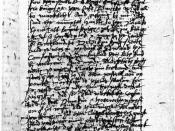Imagery, irony, and contradiction hold much importance to successful writing. Shakespeare, an incredibly skilled writer, used these to write a play titled Macbeth. In this play imagery, irony, and contradiction help to explain the themes of the play. One of the most important themes is betrayal. Betrayal is shown often in the play through imagery, irony, and contradiction.
In the first act the theme betrayal has already becoming evident. There is a want for power which leads to betrayal of the king. In act I, scene IV the king says, "There's no art to find the mind's construction in the face: he was a gentlemen on whom I built an absolute trust." (Shakespeare 11). Through this irony we can see betrayal. The king is telling Macbeth he could not see the man's betrayal on his face, and yet Macbeth is once again doing this to the king.
This is one quote in which we can see the theme, betrayal through irony in Macbeth, an ironic play.
Contradiction in the play also helps to support the theme of the play. Betrayal is often shown through contradictions because every contradiction in one way or another. In act I, scene I the quote "fair is foul and foul is fair" shows how even things that appear good can be deceiving and deceit is betrayal (Shakespeare 10). In this quote everything that is good betrays the king, and beneath it is truly bad. This is how contradiction helps to support the theme, betrayal in the play Macbeth.
Imagery also shows betrayal in the play Macbeth. In act I scene III Macbeth is accompanied by three witches. "Into the air, and what seemed corporal melted as breath into the wind." in this quote Macbeth is showing the betrayal of...


